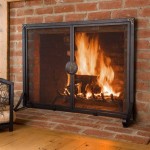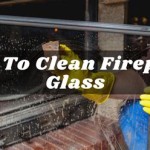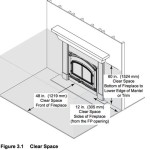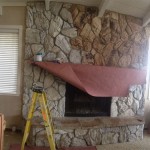Removing a Brick Fireplace Surround: A Comprehensive Guide
Removing a brick fireplace surround is a significant undertaking, typically undertaken to modernize a room, address structural concerns, or prepare the area for a different fireplace design. This process requires careful planning, the right tools, and an understanding of basic demolition techniques. Proceeding without adequate preparation can lead to unintended damage to surrounding structures and potential safety hazards.
Before commencing any work, it’s crucial to ascertain the purpose of the brick surround. Is it purely decorative, or does it contribute to the structural integrity of the fireplace? In older homes, brick surrounds might be integrated into the chimney structure, providing crucial support. Removing such a surround without proper evaluation can compromise the chimney's stability.
A thorough inspection is the initial step. Examine the interface between the brick surround, the wall, and the firebox. Note the presence of any visible cracks or signs of deterioration. Determine the bonding agent used – typically mortar – and assess its condition. This will influence the tools and techniques required for removal.
Safety is paramount. Protective eyewear, gloves, and a dust mask or respirator are essential. Brick dust can be harmful if inhaled, and debris can pose a risk to eyes and skin. The work area should be well-ventilated to minimize dust exposure.
Preparation of the surrounding area is also critical. Cover floors and furniture with drop cloths to protect them from debris. Consider hanging plastic sheeting to contain dust and prevent it from spreading to other parts of the house. Clear the area of any obstructions to allow for safe and efficient movement.
The tools required for removing a brick fireplace surround vary depending on the complexity of the project and the type of mortar used. A cold chisel, brick hammer, hammer drill, and angle grinder are common implements. A pry bar and reciprocating saw might also be necessary for stubborn sections. Additionally, buckets or containers are needed to collect debris, and a shop vacuum will facilitate cleanup.
Understanding the Fireplace's Structure
The construction of a fireplace can vary greatly depending on its age, design, and local building codes. Before attempting to remove the brick surround, it is essential to understand how the various components of the fireplace are interconnected. This knowledge will help prevent unintended damage to the firebox, chimney, or surrounding wall structure.
The firebox is the area where the fire is built. It is typically constructed of firebrick, a material designed to withstand high temperatures. The firebox is connected to the chimney through a smoke chamber and flue. The chimney is designed to vent smoke and gases safely away from the building. The brick surround might be directly attached to the firebox, or it might be built around it as a separate decorative element.
In some cases, the brick surround might be attached to the wall with metal ties or anchors. These must be located and carefully detached before attempting to remove the brick. Look for signs of these anchors along the mortar joints or embedded within the brick itself. Cutting these anchors can greatly simplify the removal process and prevent damage to the wall.
Older fireplaces often incorporate a lintel, a horizontal beam that supports the weight of the chimney above the firebox opening. The brick surround might be resting on this lintel or integrated into its support structure. If the surround is providing structural support to the lintel, removing it without alternative support measures could lead to the lintel sagging or even collapsing. In such cases, consulting with a structural engineer is highly recommended.
It is also important to identify any gas lines or electrical wiring that might be running behind or within the brick surround. If a gas line is present, it must be shut off and capped off by a qualified professional before any demolition work begins. Electrical wiring should also be disconnected and capped off to prevent electrical shock.
Carefully evaluate the mortar joints. Older mortars were typically lime-based, while newer mortars are often cement-based. Lime-based mortars are generally softer and easier to remove than cement-based mortars. This will influence the choice of tools and techniques used to remove the brick.
The Process of Brick Removal
The actual brick removal process should proceed systematically, beginning at the top of the surround and working downwards. This minimizes the risk of bricks falling unexpectedly and causing injury or damage. It's generally preferable to remove individual bricks rather than attempting to remove large sections at once.
Using a cold chisel and brick hammer, carefully chip away the mortar surrounding each brick. Aim for the mortar joints between the bricks, working to create a gap between the brick and the wall. Avoid striking the brick directly with the hammer, as this can cause it to crack or crumble. Gentle, controlled taps are more effective than forceful blows.
If the mortar is particularly stubborn, a hammer drill with a chisel bit can be used to loosen it. Exercise caution when using a hammer drill, as it can be quite powerful and can easily damage the surrounding structure if not handled carefully. Use a slow speed and light pressure to avoid overdoing it.
Once the mortar has been sufficiently loosened, use a pry bar to gently lever the brick away from the wall. Start with the bricks at the top of the surround and work downwards, supporting the bricks as they are removed to prevent them from falling. If the brick is tightly adhered to the wall, continue chipping away at the mortar until it can be safely removed.
For bricks that are particularly difficult to remove, an angle grinder with a diamond blade can be used to cut through the mortar joints. This is a more aggressive method that should only be used when other techniques have failed. Wear appropriate safety gear, including a dust mask or respirator, when using an angle grinder, as it will generate a significant amount of dust. Make sure to cut deep enough to remove the brick without damaging the surrounding wall.
As each brick is removed, inspect the wall behind it for any signs of damage or deterioration. Repair any cracks or holes before proceeding with the next brick. This will help ensure the structural integrity of the wall.
Continue removing the bricks in this manner until the entire surround has been removed. Take your time and work carefully to avoid damaging the surrounding structure. Remember, patience and precision are key to a successful removal.
Dealing with Obstacles and Challenges
Removing a brick fireplace surround can present various unexpected obstacles. Addressing these challenges effectively is crucial for a successful outcome.
One common issue is dealing with particularly stubborn mortar. Over time, mortar can become extremely hard and difficult to remove, especially if it is cement-based. In these cases, a combination of techniques might be necessary, including using a hammer drill, an angle grinder, and chemical mortar removers. Chemical mortar removers should be used with caution, as they can be corrosive and can damage surrounding materials. Always follow the manufacturer's instructions carefully when using these products.
Another challenge is encountering unexpected structural elements, such as metal ties or anchors. These are often used to secure the brick surround to the wall. Before attempting to remove these elements, it is important to understand how they are attached and what their purpose is. In some cases, they can be cut off with a reciprocating saw or an angle grinder. In other cases, they might need to be carefully detached from the wall.
Older fireplaces often have electrical wiring or gas lines running behind the brick surround. These must be addressed before any demolition work begins. Electrical wiring should be disconnected and capped off by a qualified electrician. Gas lines should be shut off and capped off by a qualified gas fitter. Failure to address these issues can result in serious injury or property damage.
During the removal process, it is possible to damage the firebox, chimney, or surrounding wall structure. If this occurs, it is important to assess the damage and determine the appropriate repair strategy. Minor damage can often be repaired with patching compounds or mortar. More significant damage might require the services of a qualified contractor.
Dust control is a constant challenge during brick removal. Brick dust is fine and pervasive and can easily spread throughout the house. To minimize dust, use drop cloths to cover floors and furniture, hang plastic sheeting to isolate the work area, and use a shop vacuum to clean up debris as you go. Wearing a dust mask or respirator is essential to protect your lungs from inhaling brick dust.
Finally, disposing of the removed brick and mortar can be a logistical challenge. Brick is heavy and bulky, and it can be difficult to transport. Check with your local waste management authority for guidelines on proper disposal. You might need to rent a dumpster or hire a junk removal service to dispose of the debris.
Successfully removing a brick fireplace surround requires careful planning, the right tools, and a systematic approach. By understanding the structure of the fireplace, employing appropriate removal techniques, and addressing potential obstacles effectively, it is possible to remove a brick fireplace surround safely and efficiently.

Fireplace Demolition Day The Handyman S Daughter

Removing Fireplace S Brick Facade Not So Hard
How To Remove My Too Big Hearth Help Com Forums Home

Fist Step Was To Remove The Brick Face And Raised Hearth A 2 Cold Chisel 3lb Sledge Easily Separated Fireplace Remodel Family Room Makeover

Simple Ways To Remove A Brick Fireplace With S Wikihow

Fireplace Demolition Day The Handyman S Daughter

How To Remove A Fireplace Hearth All You Need Know Checkatrade

How To Remove Brick The Easy Way Project Allen Designs

Simple Ways To Remove A Brick Fireplace With S Wikihow

Our Favorite Flip Or Flop Before And After Makeovers Brick Fireplace Remodel Makeover
Related Posts








